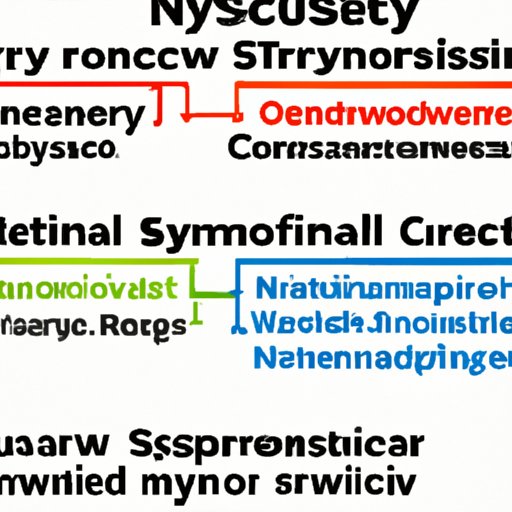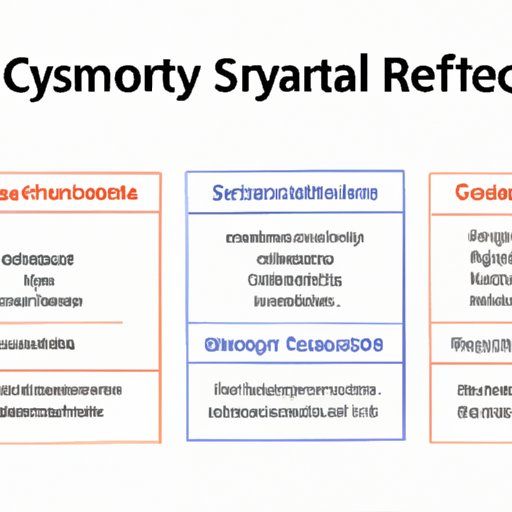Introduction
Cybersecurity frameworks are a set of standards, guidelines, best practices and procedures that help organizations protect their information systems from malicious attacks and cyber threats. These frameworks provide the foundation for organizations to effectively manage and secure their data, networks, and applications. By implementing these frameworks, organizations can ensure their systems are safe from external threats and maintain compliance with industry regulations.

Comparative Analysis of Popular Cybersecurity Frameworks
When it comes to selecting the best cybersecurity framework for your organization, there are numerous options available. Each framework has its own unique set of benefits and challenges. It’s important to understand the strengths and weaknesses of each framework before making any decisions. Here is a comparative analysis of some of the most popular cybersecurity frameworks on the market today:
Benefits and Challenges of Different Cybersecurity Frameworks
The National Institute of Standards and Technology (NIST) Cybersecurity Framework (CSF) is a comprehensive, risk-based approach to managing and protecting organizational assets. The CSF provides organizations with a structured approach to identify, assess, and manage cyber risks. It is designed to be flexible and scalable, so organizations can tailor it to meet their specific needs. Benefits of using the CSF include improved visibility into current cyber risks and increased ability to respond quickly to emerging threats. Some of the challenges associated with the CSF include the complexity of the framework and difficulty in obtaining resources needed to implement the framework.
The Center for Internet Security (CIS) Controls is another popular cybersecurity framework. This framework focuses on reducing the attack surface of an organization by implementing 20 essential security controls. These controls are designed to protect an organization’s data, networks, and applications from malicious actors. Benefits of using CIS Controls include improved security posture and reduced risk of successful cyberattacks. Challenges associated with the framework include the need for continuous monitoring and the difficulty of implementing the controls on a large scale.
The International Organization for Standardization (ISO) 27001 is a widely adopted international standard for information security management. This standard provides organizations with a framework for developing, implementing, and maintaining an effective information security management system. Benefits of using ISO 27001 include improved security posture and increased ability to comply with regulatory requirements. Challenges associated with this framework include the complexity of the standard and the cost of implementation.
How to Choose the Right Cybersecurity Framework for Your Business
Choosing the right cybersecurity framework for your organization is an important decision. It’s important to consider your organization’s specific needs and objectives when selecting a framework. It’s also important to evaluate the features, functions, and security requirements of each framework to ensure you select the best one for your business.
An Overview of the Top Cybersecurity Frameworks on the Market Today
Features, Functions, and Applications of Different Cybersecurity Frameworks
The NIST Cybersecurity Framework (CSF) is a comprehensive, risk-based approach to managing and protecting organizational assets. It provides organizations with a structured approach to identify, assess, and manage cyber risks. The CSF includes five core functions – Identify, Protect, Detect, Respond, and Recover – which are designed to help organizations protect their systems from external threats. The framework also includes a set of security categories that organizations can use to assess their current security posture and identify areas for improvement.
The Center for Internet Security (CIS) Controls is a set of 20 essential security controls designed to reduce an organization’s attack surface. The controls focus on key areas such as network security, application security, patch management, identity and access management, and incident response. The controls are designed to be implemented in phases, allowing organizations to gradually improve their security posture over time. Additionally, the controls are organized into three groups – Basic, Foundational, and Organizational – which makes it easier for organizations to prioritize their security efforts.
The International Organization for Standardization (ISO) 27001 is a widely adopted international standard for information security management. This standard provides organizations with a framework for developing, implementing, and maintaining an effective information security management system. ISO 27001 includes a set of security controls that organizations must implement in order to achieve compliance with the standard. The standard also includes processes for auditing, monitoring, and reporting on security performance.
Security Requirements and Capabilities of Each Framework
Each cybersecurity framework has its own set of security requirements and capabilities. The NIST Cybersecurity Framework (CSF) is designed to be flexible and scalable, allowing organizations to tailor the framework to meet their specific needs. The framework also provides organizations with guidance on how to develop, implement, and maintain an effective security program. Additionally, the CSF includes a set of security categories that organizations can use to assess their current security posture and identify areas for improvement.
The Center for Internet Security (CIS) Controls is designed to reduce an organization’s attack surface by implementing 20 essential security controls. These controls are organized into three groups – Basic, Foundational, and Organizational – which makes it easier for organizations to prioritize their security efforts. Additionally, the CIS Controls provide organizations with detailed guidance on how to implement each control, as well as best practices for monitoring and assessing the effectiveness of their security program.
The International Organization for Standardization (ISO) 27001 is a widely adopted international standard for information security management. This standard provides organizations with a framework for developing, implementing, and maintaining an effective information security management system. The standard includes a set of security controls that organizations must implement in order to achieve compliance with the standard. Additionally, the standard includes processes for auditing, monitoring, and reporting on security performance.

A Guide to Selecting the Best Cybersecurity Framework for Your Organization
Selecting the right cybersecurity framework for your organization is an important decision. It’s important to consider your organization’s specific needs and objectives when selecting a framework. It’s also important to evaluate the features, functions, and security requirements of each framework to ensure you select the best one for your business.
Identifying Your Needs
The first step in selecting the right cybersecurity framework for your organization is to identify your needs. Consider your organization’s size, industry, and objectives when evaluating frameworks. Also consider the types of threats you are likely to face and the level of security you need to protect your assets.
Assessing the Security Requirements of Each Framework
Once you have identified your needs, you can begin to assess the security requirements of each framework. Evaluate the features, functions, and security categories of each framework to determine if it meets your security needs. Consider the complexity of the framework and the resources required to implement and maintain it.
Comparing Security Capabilities of Different Frameworks
Once you have identified your needs and assessed the security requirements of each framework, you can begin to compare their security capabilities. Assess the features, functions, and security categories of each framework to determine which one best meets your organization’s needs. Consider factors such as scalability, flexibility, and ease of implementation.
Making an Informed Decision
The final step in selecting the best cybersecurity framework for your organization is to make an informed decision. Evaluate the features, functions, and security requirements of each framework to determine which one best meets your security needs. Consider the costs and resources required to implement and maintain the framework, as well as the complexity of the framework.
Conclusion
There are numerous cybersecurity frameworks available on the market today. It’s important to consider your organization’s specific needs and objectives when selecting a framework. Evaluate the features, functions, and security requirements of each framework to ensure you select the best one for your business. By following these steps, you can ensure your organization has the best possible protection against cyber threats.
(Note: Is this article not meeting your expectations? Do you have knowledge or insights to share? Unlock new opportunities and expand your reach by joining our authors team. Click Registration to join us and share your expertise with our readers.)
